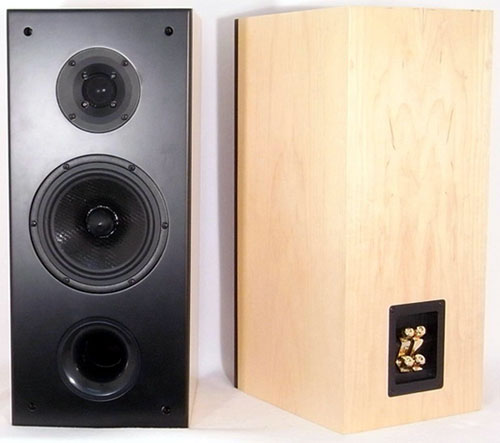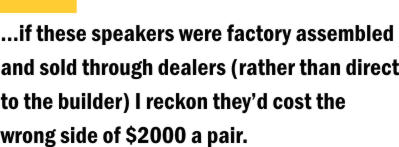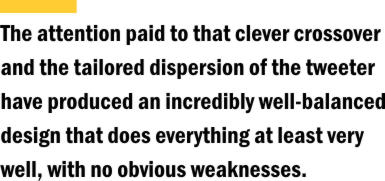SEAS • Idunn Loudspeaker Kit
I checked out the Idunn online and saw a very conventional-looking design with a couple of interesting features. I looked forward to hearing it on my next visit to Murray’s, and not surprisingly it was excellent, delivering great sound for minimal cost. So when Madisound produced an Idunn kit for under $700 a pair, I just knew it needed a review. Despite the Idunn’s ordinary looks, you don’t need to dig too deep to discover what makes it special. Both drivers are more interesting than they first appear. The woofer is a 6 1/2" polypropylene driver with a cast basket. The magnet structure is designed to minimize high-end inductance, with its associated high-end roll-off. The driver's response curve is very smooth, with noticeably less top-end breakup than usual. But what is most different about the design is that the cone is not one integral piece but is made of woven polypropylene, the first time I’ve ever seen this construction. Most polypropylene cones are single molded pieces. I’m only guessing, but this new approach appears to maintain the positive features of the material (good midrange damping) and ameliorate some of its problems (like "polypropylene honk"). The tweeter is also a bit unusual. It uses 1" aluminum-alloy dome and a compensation magnet that increases sensitivity and reduces the stray magnetic field. That’s relatively conventional and has been done before. But it’s the mounting plate that is special. It’s a waveguide that modifies the dispersion of the dome, narrowing it lower down in its range and expanding it at high frequencies. The former has been done before. The latter is unique as far as I know. At first you might think that narrowing dispersion would be a bad thing, but it’s not. You routinely hear listeners comment that they can "hear the crossover" between the woofer and tweeter of a two-way speaker, but more often than not, the real villain is not the crossover but the change in dispersion through the crossover frequency. The bass/midrange driver’s output narrows as its frequency rises, whereas the tweeter has much wider dispersion at the frequency where they meet. The designer has to decide whether to maintain flat on-axis response at the expense of power response, or to compromise them both. By narrowing the tweeter's dispersion so it’s close to the woofer spread, a good designer can make the crossover acoustically disappear much more easily, while still enjoying the benefits of wider dispersion at higher frequencies. Checking out the Idunn crossover reveals a classic acoustic fourth-order Linkwitz-Riley transfer function, beautifully engineered from just five components, with a further two resistors to match the drivers' sensitivity. When you consider that these seven parts equalize anomalies in the drivers as well as provide the transition between them, you have to smile at the economy and elegance of such a design. This is the work of a designer who knows what he is doing. hese days, building your audio system from kits seems like a pretty alien idea, but back in the 1950s and 1960s many major manufacturers offered self-assembly versions of their products. Heathkit and Dynaco were the giants of the build-it-yourself industry, but there were plenty of others, such as Fisher, Scott, Allied, Lafayette and Acoustech. They provided products that were fun to make and allowed lots of us into the audio hobby who otherwise wouldn’t have been able to afford the products, playing a central role in creating the industry we have today.
The review pair used Madisound’s own pre-built 20-liter cabinets. That’s no coincidence. Twenty liters is a standard volume, with plenty of off-the-shelf cabinets available to home constructors who don’t want to get involved in carpentry. The Madisound boxes are beautifully finished with real veneer, not vinyl, on the visible surfaces (you get a choice of black ash, cherry or maple). The front panel is separate, precut, and finished in black paint. Everything needed to complete the speakers comes with the kit, except the tools, solder and some glue, with full details available on the Madisound website.
etting up conventional speakers in my room is not usually difficult. Get them away from the walls, position the tweeters around ear height and toe the speakers in a bit and I’m pretty much done. This worked fine for the Idunns, but a little more work with toe-in gave improved results. In my environment, the speakers sounded best pointed directly at me. It wasn’t imaging that was affected but octave-to-octave balance and presence. In Murray’s room, the Idunns don’t need anything like such precise aiming, so you’ll want to experiment a little. Of course, stand-mounted speakers need stands to be mounted on. These should be as rigid as possible with minimal exposed area. Speakers transfer energy to the stands, which become secondary sound radiators (just like speaker cabinets). The less they vibrate and the smaller the radiating area, the better the sound. Ideally spikes are the preferable floor connections. They minimize speaker motion, providing a more stable situation for the drivers. Sometimes, because spikes couple to the floor and transmit energy into it, you can get mechanical feedback into the rest of the system, but my preferred solution here is to decouple and isolate the other components and maintain the speaker-floor coupling, if at all possible. Proper mechanical grounding of the Idunns made a significant difference to their musical performance, and that’s how I auditioned them. he Idunns are very good speakers that do everything well, except for the obvious missing bottom octave -- that octave that only very costly, very large loudspeakers produce convincingly. Not surprisingly, they are not state of the art, but at $700 a pair, it would be a miracle if it were. What they are is easily good enough that, after four decades as an audiophile, I can get home after listening to some exotic, expensive design, or switch to them from my own reference speakers, without having my listening diluted by thoughts of those more expensive alternatives. This is a speaker I could live with if I ran into financial difficulties -- and that’s a heck of a performance-per-dollar proposition. Decades ago, my old friend, Bud Fried, of IMF and Fried loudspeakers, used the term "dynamic linearity" to describe speaker performance. It took me some time to realize what he was referring to. It wasn’t dynamic range, although that’s part of it. It’s accurate, linear changes, both macro and micro in level. Poor dynamic linearity makes a speaker sound like a clean, wideband radio. It’s the most important ingredient in simulating live sound as far as I’m concerned. And I believe it’s the factor most compromised in speakers. Once you’ve heard a speaker with superior dynamic linearity, you’ll realize how few speakers do it well. That’s why the first two CDs I play on new speakers are nearly always the Kissin piano version of Pictures at an Exhibition [RCA BG2 63884] and The Pentangle [Castle 06076 81120-2] -- both of which I've mentioned in previous reviews. Piano may be the most difficult instrument to reproduce. It can produce prodigious level changes that start and stop very rapidly or last for split seconds. Starting rapidly is difficult enough, but as a speaker has inherent resonances both mechanical and electrical, it’s stopping that is most difficult. The Kissin CD is a super tool for auditioning this, and the Idunn was excellent here. In the Kissin performance, the only significant compression comes where the recording contains very high energy combined with low frequencies. The laws of physics make that unavoidable with small speakers with limited bass response and ability to move air. Otherwise, the Idunn did a good job of capturing Kissin's piano without sounding overly damped, as it does with too many speakers. The piano on this recording is hard and it clanged on the Idunn, just as it does on good systems. Switching to The Pentangle, I listened to the close-miked acoustic guitars; if a speaker possesses dynamic agility, like the Idunn, I hear a twang and a clear aftertone, not just simple strumming. Along with nimble dynamics, I want to hear attack and decay clearly. They are both important, but as I mentioned in the previous paragraph, I find that with many speakers it’s the reproduction of decay that is missing more than the sense of attack. Starting, stopping and dynamics are all interrelated. It’s that guy Newton who described the problem. An object set in motion tends to stay in motion. A speaker is a resonating device and those resonances will stay around once excited -- if they’re not controlled. I use both The Pentagle and the Kissin CDs again here, listening to the attack and decay of the guitars and piano. I also find the drums on The Pentangle excellent for checking decay in the midbass, a region where a lot of speakers get it wrong. The Idunn exposed layers of information; once again, it was very good -- good enough to stop me from switching into audio-critic mode. The frequency curves on the SEAS site show a very flat response, and that’s how the Idunn sounded: without obvious tonal aberrations. A good orchestral/vocal recording like the Rutter Requiem CD [Reference Recordings RR-57CD] exhibits excellent timbral and octave-to-octave balance. I have to state here that I find frequency coloration of secondary importance to dynamics and attack when it comes to producing the sense of live sound. Just move around to different seats at a concert and the balance changes -- but it still sounds "live." If I have to choose between ultra-flat response and dynamics I will pick dynamics every time. But I’m an audiophile; I still want flat response if I can get it. A good speaker should be able to deliver both, and the Idunn did just that. The Idunn’s top-end was very smooth, even though the tweeter has a metal dome with its characteristic supersonic peak. You can see this peak on the SEAS site, but it is far above our hearing range; besides, brightness associated with tweeters is usually at the bottom of their range, often a result of a non-optimum high-pass crossover rather than the top octave that we tend to blame. One of the first classical pieces I bought, long, long ago, was the Columbia Bernstein Shostakovich Fifth [Sony SMK 61841], and it’s still one of my all-time favorites. The CD, like the original LP, makes the top of the strings sound wiry and bright on most flat speakers, but the Idunns, which also measure flat, reduced this effect significantly. I suspect it’s a combination of a good tweeter, proper crossover design and the increased high-frequency dispersion previously discussed, with its attendant improved power response, that help the Idunn succeed here. My friend Murray describes this effect as "95% accurate and 5% forgiving," and he’s got it right. This speaker gives you lots of information but in a way that still allows less-than-ideal recordings to be enjoyed. Bass, especially the midbass, is often a problem area for small speakers. There are a couple of causes. One is trying to meet the desire of too many buyers to really hear the bass they paid for -- quantity before quality, in other words. The other is the difficulty, given current bass-driver design, in producing quantity and quality, especially with small speakers. Quality is all about damping, controlling the resonance of bass decay, the Q of the system. Bass rolls off rapidly below the speaker-system's resonance point. For two-way designs of this size, this resonance is generally in the 40Hz range or above, leaving at least one octave of reproduction weak. An ideal Q, critical damping, will exhibit slow roll-off even above the resonance point. In a closed-box with critical Q of 0.5, the system will be 6dB down at the resonance point and is 3dB down at a little over 1.5 times the resonance. Unless the system resonance is way down into the 20Hz range, the speaker will sound bass shy and probably unsellable. Non-optimum damping gets rid of this leanness but trades away bass quality. The venerable LS3/5A is a prime example of this; the original, pre-PUPPY Wilson WATT was that rare example of the lean, damped approach. So critical damping is extremely rare and balancing system resonance and damping is a difficult job. Underdamping produces bloated midbass, which also obscures the lower midrange and weakens transparency. The long and short of it is that unless the speaker is large with deep bass well down into the 20s, if it is properly damped, it will sound thin and if it is excessively underdamped the bass will be bloated. Given these problems the Idunn designer, working with a system resonance in the mid-40Hz range did an impressive job of balancing bass quality and quantity. I listened to the drums on The Pentangle, and if I can clearly sense their decay after being struck, I know the bass is nicely controlled. The cleaner the decay the better the control. And I can’t imagine it done much better than with the Idunn, given the limitations inherent in this style of speaker.
But one performance factor was magic: the soundstaging and imaging. The Idunn threw a rock-stable, three-dimensional sound picture where the individual elements had genuine body, a real physical sense. Just put on the Rutter Requiem again and sit back to enjoy the lifelike soundstaging. Or, if you are feeling nostalgic, put on Jazz at the Pawnshop [Proprius PRCD 7778]. Close your eyes and you’ll feel like you’re in the jazz club where it was recorded. You can the sense position, shape and weight of each individual component in the recording. Play any of your recordings with outstanding imaging with the Idunns, and I bet you’ll be smiling. or $700 a pair, the Idunns offer excellent value. In the sidebar, I discuss possible ways you might get even more out of this unassuming box, but even in stock form it is like getting a speaker system worth at least two to three times what the kit costs. I could live with it just the way I received it. For a couple of hundred dollars more, simple changes will make it even more impressive. The Idunn is in extremely select company: one of that
(very) small group of components that deliver a genuine taste of the high end without the
high price. It’s like a first-growth wine on a house wine list, or vintage without
the wait. Getting your hands a little dirty will rarely be so rewarding.
|


 Back then, most of the kit
manufacturers made electronics, but today that focus has shifted to speakers, partly
because they’re so simple to build, especially with an assembled crossover board and
a finished enclosure. So they make a really good first step into building your own. I
can’t actually comment on building the Idunns, because I was loaned a finished pair,
but as a non-scientific estimate I’d guess that 98 percent of audiophiles could
assemble these speakers without a problem. Murray, who built his speakers before the full
kit was available, confirms this. But as much fun as building this kit is, there’s no
denying that the principle appeal lies in the money saved. Another guess -- if these
speakers were factory assembled and sold through dealers (rather than direct to the
builder) I reckon they’d cost the wrong side of $2000 a pair.
Back then, most of the kit
manufacturers made electronics, but today that focus has shifted to speakers, partly
because they’re so simple to build, especially with an assembled crossover board and
a finished enclosure. So they make a really good first step into building your own. I
can’t actually comment on building the Idunns, because I was loaned a finished pair,
but as a non-scientific estimate I’d guess that 98 percent of audiophiles could
assemble these speakers without a problem. Murray, who built his speakers before the full
kit was available, confirms this. But as much fun as building this kit is, there’s no
denying that the principle appeal lies in the money saved. Another guess -- if these
speakers were factory assembled and sold through dealers (rather than direct to the
builder) I reckon they’d cost the wrong side of $2000 a pair. Most great audio products
have one standout feature -- their own little bit of magic. It might be oxymoronic to
point to the integration and continuity of single-driver speakers, or the class-A
qualities of SET amplifiers, given that they are in the very nature of those designs.
Instead, the success of those products depends on how well they can overcome their
inherent weaknesses -- bandwidth for the speakers, power output for the SETs. What set the
Idunn apart from the crowd was the way it took what should have been a weakness and made
it a strength. The attention paid to that clever crossover and the tailored dispersion of
the tweeter produced an incredibly well-balanced design that did everything at least very
well, again with no obvious weaknesses.
Most great audio products
have one standout feature -- their own little bit of magic. It might be oxymoronic to
point to the integration and continuity of single-driver speakers, or the class-A
qualities of SET amplifiers, given that they are in the very nature of those designs.
Instead, the success of those products depends on how well they can overcome their
inherent weaknesses -- bandwidth for the speakers, power output for the SETs. What set the
Idunn apart from the crowd was the way it took what should have been a weakness and made
it a strength. The attention paid to that clever crossover and the tailored dispersion of
the tweeter produced an incredibly well-balanced design that did everything at least very
well, again with no obvious weaknesses.